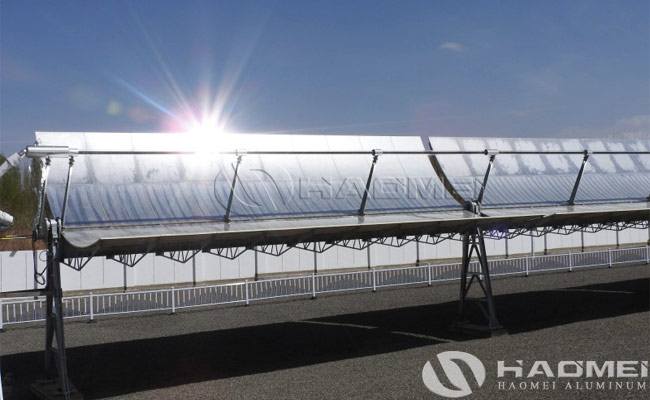For solar reflectors (especially heliostats or trough reflectors in concentrated solar thermal power (CSP) systems), the mirror reflective aluminum sheet is a core component. Its quality and performance directly determine the system’s light collection efficiency and long-term operational reliability. The mirror reflective aluminum sheet for solar reflectors requires precision machining and special surface treatment to achieve excellent reflective properties, effectively reflecting sunlight to a desired location, thereby improving solar energy utilization efficiency. Its quality and performance requirements must focus on three core objectives: “efficient sunlight reflection,” “long-term stable operation,” and “adaptability to outdoor environments.”

- Core Reflective Performance Requirements
- Spectral Reflectivity
– Solar energy is primarily concentrated in the 300-2500nm band (visible light 400-760nm + near-infrared 760-2500nm). A reflectivity of ≥90% is required in this band (standard requirement). For advanced scenarios (such as tower-mounted CSP), a ≥95% reflectivity is required to maximize light utilization. – Reflectivity requirements for the UV band (<300nm) may be relaxed, but surface overheating due to absorption must be avoided.
- Reflectivity Stability
– After long-term use (over 10 years), the reflectivity decay rate must be ≤1%/year (simulating outdoor aging test results) to avoid a significant decrease in system efficiency due to decay.

2. Surface Quality Requirements
- Surface Finish
– The surface of reflective aluminum sheet for solar reflector must be free of defects such as scratches, oil stains, oxidation spots, and pinholes (defect area ≤0.01mm²/㎡), as these will cause light scattering and reduce reflective efficiency.
– The surface roughness (Ra) must be ≤0.1μm (some high-end applications require ≤0.05μm) to ensure that light is primarily reflected from the surface and minimize diffuse reflection losses.
- Mirror Surface Flatness
– The flatness error must be ≤0.5mm/m (adjusted according to the reflector curvature design) to prevent surface irregularities from causing reflected light to shift in focus, affecting heat collection accuracy (for example, trough reflectors need to focus on the heat absorber tube; insufficient flatness can cause the light spot to shift).
3. Weatherability Requirements (Suitable for Outdoor Environments)
- Corrosion Resistance
– Salt Spray Resistance: Pass the neutral salt spray test (ASTM B117) for ≥500 hours, with no visible rust or coating peeling (≥1000 hours required for coastal or high-humidity areas).
– Moisture and Heat Resistance: Tested at 40°C and 95% humidity for ≥1000 hours, with a reflectivity loss of ≤3% and no mildew or oxidation.
- UV Aging Resistance
– After a UV aging test (such as the QUV test, simulating outdoor UV exposure) for ≥3000 hours, the surface must show no cracking or chalking, with a reflectivity loss of ≤5%. 3. High and Low Temperature Cycling Resistance
– After 100 cycles of cycling tests at -40°C to 80°C (-50°C to 100°C in extreme regions), no deformation, coating peeling, or significant changes in reflectivity or flatness are observed.
4. Mechanical and Structural Performance Requirements
- Substrate Mechanical Properties
– The aluminum substrate (e.g., 3003 and 5052 aluminum alloys) must possess sufficient strength (tensile strength ≥ 150 MPa) and elongation (≥ 15%) to meet the requirements of forming processes (e.g., bending and rolling into grooved/disc shapes) and avoid cracking during processing.
– Impact Resistance: After a drop ball impact test (a 1 kg steel ball dropped from a height of 1 meter), no dents or cracks are observed on the surface.
- Thermal Stability
– The thermal expansion coefficient must be stable (matching the reflector bracket material), with a fluctuation of ≤5% within the -40°C to 80°C range to prevent mirror deformation and focus shift due to temperature changes.
5. Dimension and Precision Requirements
- Thickness Tolerance: The aluminium reflective sheet thickness (commonly 0.3-1.0mm) must be within ±0.03mm to ensure consistent curvature after forming.
- Dimensional Consistency: Length/width tolerances must be ≤ ±1mm, with burr-free edges (burr height ≤0.1mm) to facilitate assembly and avoid blind spots caused by seams.
6. Coating Performance (for Products with Coatings/Platings)
– If the reflective layer (e.g., SiO₂/Al composite coating) is applied to the mirror surface via vacuum aluminum plating, electroplating, or magnetron sputtering, the following must be met:
– Coating Adhesion: Cross-cut test (ASTM D3359) ≥ Grade 5B (no coating detachment).
– Coating Uniformity: Spatial reflectivity deviation ≤2% (across the entire panel), avoiding localized low-reflectivity areas.
7. Long-Term Reliability and Lifespan
– The design lifespan must be ≥15 years (CSP systems typically require 20-30 years). Accelerated aging tests have verified that the reflective efficiency retention rate must be ≥80% throughout the entire lifespan.
8. Environmental Requirements
– Comply with environmental standards such as RoHS and REACH, prohibiting the use of hazardous substances such as lead, cadmium, and hexavalent chromium to prevent environmental pollution after production or disposal.
In summary, reflective aluminum sheet for solar reflector must meet stringent standards for the three core performance characteristics of “high reflectivity + high stability + environmental resistance” to meet the requirements for efficient and long-term operation of solar reflectors. Haomei Aluminum are specialized in the production of mirror reflective aluminum sheets for solar reflectors. Our products are widely used in a variety of applications, including solar water heaters, photovoltaic power generation systems, and solar concentrating equipment. Our mirror reflective aluminum sheets have received unanimous praise from customers for their excellent performance and durability. Whether you are a large enterprise or a small project, we can provide customized solutions tailored to your needs. We welcome collaborations and collaborations to promote the development of the solar industry.
Contact Us
- 1103, No.14 Waihuan Road, CBD,Zhengzhou, China
- +86-0371-65621391
- nydia@aluminumhm.com
- Contact Form

